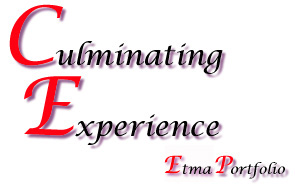

For this first class session, please come prepared to present the following items:
What we want to do is to tie the problem/purpose statement with a reference that can be cited immediately or later in your review of the literature. The reference mentioned above will appear in your lit review. Your reference may even be taken from school site archives (staff meeting minutes or surveys) indicating a problem or need. This can be considered reconnaissance. Below is an example of a problem / purpose statement that links to a reference that will be cited in the rationale or review that follows.
Thinking and technology need to be integrated with the elementary school curriculum. By 1985, there were at least one million computers in American classrooms, but they were not being used as tools to teach the intellectual skills of problem solving. (This reference authoritatively addresses the "So what?" factor and will be cited later in the review.) This study addresses this problem by linking technology commonly found in elementary classrooms with current curricula and robust teaching strategies.
We have sent an example of a rationale along with a review of literature, but be prepared to present drafts of your ideas that may establish a purpose for your to the above introductory paragraph. Additional paragraphs may certainly be supplied in making a strong rationale. Below is an example that is slightly longer and, perhaps, stronger.
The purpose of this study is to investigate the effectiveness of peer coaching in technology and the performance of sixth grade students on standardized tests. Advanced networking and computing technologies have entered the K-12 learning environment at a rate that has left educators unprepared. As the cost of hardware declines and the quality of software applications improves, there is a perception that the use of computing technology as a learning tool should be a basic skill (Glennan & Melmed, 1996). Nevertheless, according to a recent report from CEOs of business and industry, "...the gap between technology presence in schools and its effective use is still too wide." (Crane & Spoon, 1999) The U.S. Department of Education recognizes that this gap exists and responded in a directive in 1994 "...to develop a national long-range technology plan for actions promoting higher student achievement through the use of technology in education." (Glennan & Melmed) This directive implies a connection between student achievement and strategies that has yet to be fully researched. Hence, staff development procedures must be devised that equip educators with strategies that address blending computing technologies with the standards-driven curriculum.
Staff development has received much study in the last 25 years, but Joyce and Showers (1995) have found that a very low percentage of implementation occurs following staff development experiences. Citing Joyce, Jean Becker shows that 10% of teachers will transfer a new skill into practice after exposure to theory and practice, yet 90% will transfer that new skill into practice with theory, demonstration, practice, feedback and coaching (Becker, 2000 ). Peer coaching, feedback and practice provide the added elements needed for successful staff development.
To complete the requirements of the review of relevant literature, you should be prepared to do some intensive library research. You do need to make ample time for this. Think resources!
The Action Research Amigos